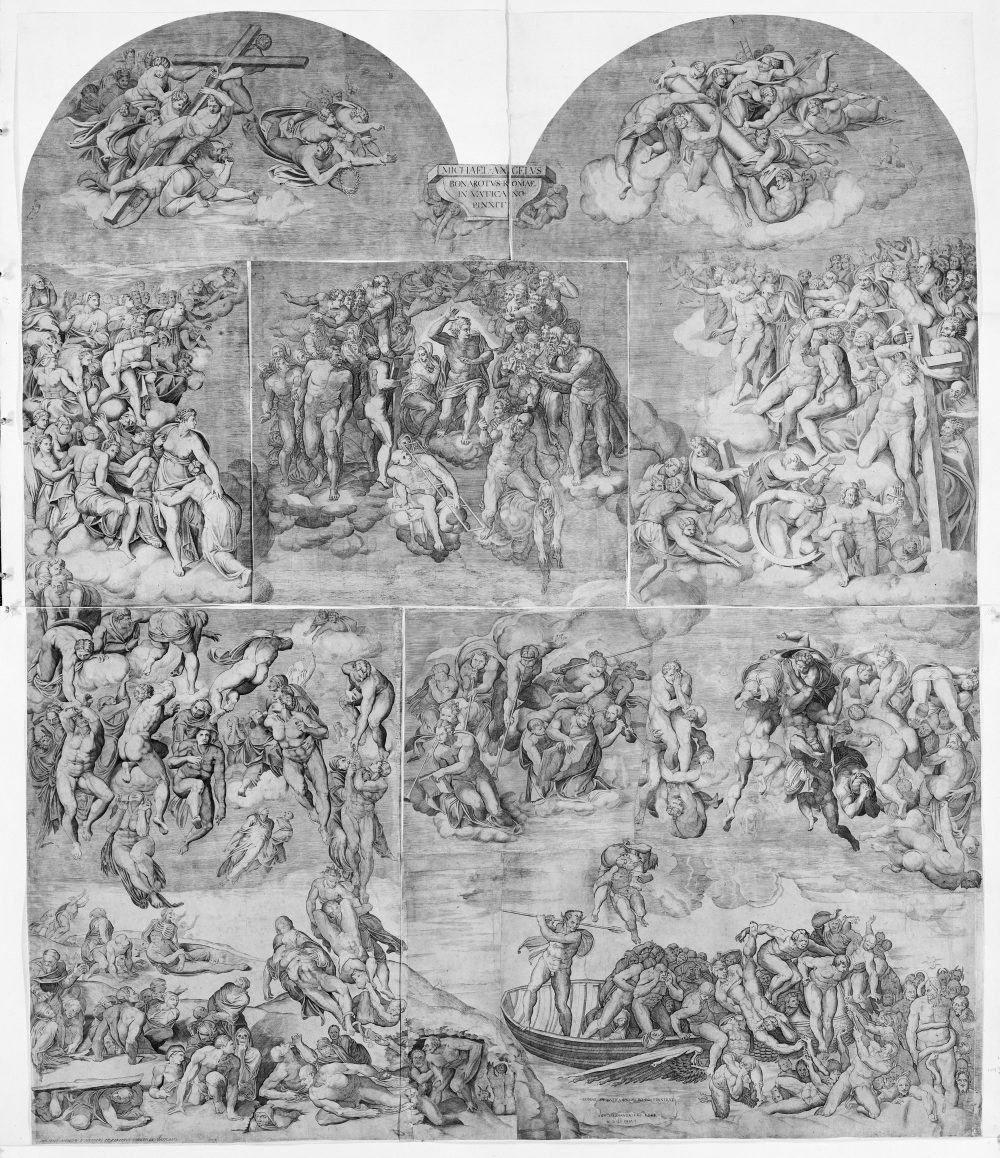
Metropolitan Museum of Art, New York, www.metmuseum.org
In this part of the passage, the characters once again focus on the representation of age, this time in the “Last Judgement”. In addition to Michelangelo’s fresco, they also mention a representation that must have been in the Oratorio San Libero in Fabriano and was executed by the artist Piersimone. (Gilio 2018, 188, n. 318)
“M. Ruggiero said: ‘[…] And another [capriccio] is that on that day there will be no old age, no childhood, no baldness or anything else that makes any part of the body ugly and deformed, as I told you earlier; yet here we see the decrepit, the bald, and children and people of all ages. Sometimes I laugh to myself thinking of a published (representation of the) Judgement, from which the painter Piersimone took the design that he painted in the Crocefisso delle Carceri. In this painting (as you know) we see Noah raising the ark high above his head; Abraham with his son Isaac as a young child carrying a small bundle of wood on his shoulder; Joshua dressed in armor, with a mace, sword, and helmet; the innocents who were slaughtered by Herod; and following other things of no consequence, our Lord sitting on a wheeled chair, under which the Devil and Death are chained, which so many ridiculous and trifling fables and fictions that I am amazed even to think of it. And being an absurd person (Piersimone) has added cauldrons filled with souls, and devils making a fire while others drag a peasant by his hair to plunge him in, and other vanities that ignorant people firmly believe will occur in that way. And these people, who defile the paper they use, are absolutely convinced, as are many, many others, that they have fulfilled what is required of them and observed the rules. If, as I said at the beginning, painters were fully to inform themselves of the truth and subject of the history they are to represent, not just once but ten times over, and if they were to study, read, reread, ask questions, and act as the most faithful interpreter should do, in the manner that benefits a good historian, then the works they make would be praiseworthy. But groping their way blindly and foolishly forward, without further thought, makes them commit endless stupid mistakes and earns them the nature of daubers who spoil walls and paper’.
M. Francesco said: ‘Such daubings should be treated as they deserve and ignored; we would do them too much honor if we were to regard them as we would beautiful and lovely things’.”
“Disse M. Ruggiero: ‘[…] L’altro capriccio è che in quel giorno non ci sarà né vecchiezza né puerizia né calvizie, né cosa alcuna che renda il corpo in qual si voglia parte difforme e brutto, come dianzi vi dissi; e quivi si veggono decrepiti, calvi, fanciulli e gente d’ogni etade. Mi vien pur a le volte da ridere, pensando in un Giudizio che va in stampa, dal quale Piersimone pittore ha cavato il disegno di quello che ha pinto nel Crocifisso de le carceri; nel quale (come sapete) si vede Noè che con le braccia alte sostiene sopra ‘l suo capo l’arca; Abraamo col suo figliuolo Isaac piccoletto fanciullo, con un fastelluzzo di legne su la spalla; Giosuè tutto vestito di ferro con mazza, stocco e morione; i fanciulletti innocenti che da Erode ammazzati furono; dopo altre chiacchiere, il Salvator nostro che siede sopra una macchina di rote, sotto i cui piedi stanno incatenati il Diavolo e la Morte, con tante baie, frascherie, favole e finzioni, che io mi stupisco a pensarvi. Et egli, come salato, v’ha aggiunte le caldaia piene d’anime, et i diavoli che vi fanno il fuoco, altri che strascinano per i capelli un contadino per tuffarvilo dentro, et alter vanità credute per fermo dagli ignoranti che in quel modo abbino da essere. E tengono per certo, questi smerdacarte, che, come hanno dimostrata gran moltitudine di gente, aver compito il precetto et osservata la regola. Se i pittori dunque, come da principio è stato detto, s’informassero a pieno de la verità e soggetto de l’istoria, non una volta sola, ma diece, e studiare, leggere, rileggere, domandare e far quello che fidelissimo interprete far deve e ch’appertene al buono istorico, farebbe le sue opere degne di lode: perché il mettersi a tentoni et a la cieca balordamente, senza altra considerazione, gli fa fare infiniti erroracci, e però se li conviene il nome di lerciamuro et imbrattacarte’.
Disse M. Francesco: ‘Cotai lerciamenti di carte bisogna, con quella considerazione che meritano, passarli via; ché si farebbe lor troppo onore, se si contemplassero come cose belle e vaghe. Ma abbiamo lasciata una cosa inresoluta’.”
Gilio 2018, 187-189, n. 317-320, fig. 19-22



